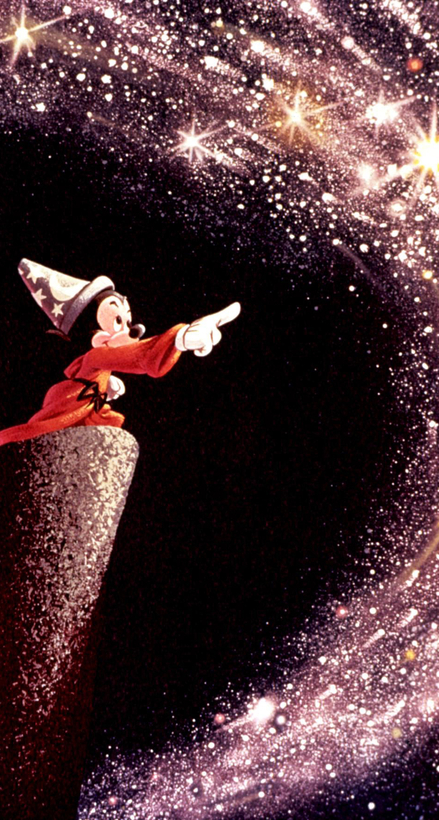Walt Disney’s seven-part paean to classical music, Fantasia, opened in 1940 to calamitous box office. While reviews were mixed, few cartoon features have been as galvanizingly influential over Pop art and high art. This audiovisual smorgasbord animates eight basic repertory pieces—including The Rite of Spring—with fanciful stories, picturesque scenes, and abstract designs. On the high side, it gave American audiences their first chance to experience The Nutcracker as intoxicating dance. Decades later, after a smash 1969 re-release as a “trip” movie, it catalyzed a new genre: the classical-music video.
On the Pop side, Fantasia’s version of The Sorcerer’s Apprentice reshaped Mickey Mouse into a Chaplin-esque figure with expressive eyes, a pinkish face, and a pear-shaped body. The T. rex and gentler dinosaurs from its Rite of Spring re-emerged in Steven Spielberg’s The Land Before Time and Jurassic Park series; and the movie’s demon-topped Bald Mountain from Night on Bald Mountain evolved into Devils Tower in Spielberg’s Close Encounters of the Third Kind. Spielberg even found an inspirational moment in the saccharine Olympus that Disney envisioned for Beethoven’s Pastoral Symphony.

During an interview about E.T. in 1982, Spielberg asked me, “Remember, in Fantasia, Mother Night flying over with her cape, covering a daylight sky? I used to think, when I was a kid, that that’s what night really looked like—a beautiful woman with flowing, blue-black hair, and arms extended outward, 20 miles in either direction. And behind her was a very inviting cloak. She came from the horizon in an arc and swept over you until everything was [under] a blue-black dome.... I wanted the opening of E.T. to be that kind of Mother Night.”
Few cartoon features have been as galvanizingly influential over Pop art and high art.
Disney developed this alternately breathtaking and kitschy classic with Leopold Stokowski, maestro of the Philadelphia Orchestra and the man who cultivated the lush yet supple “Philadelphia sound.” He conducted almost all the music with his orchestra at its longtime home, the Academy of Music. At Verizon Hall, its current venue, frequent guest Aram Demirjian will conduct selections from the soundtrack on January 3 and 4 (at seven P.M.) and January 5 (at two P.M.) as excerpts from the film unspool.

In recent years, Disney Concerts and participating orchestras have swapped extracts from the digital sequel, Fantasia 2000, for the T. rex and Bald Mountain’s Black God—a loss for those of us who know them, but they were pretty scary. So this time, concertgoers will instead see Beethoven’s Fifth pictured as a color and light show, followed by a sentimental ecological fable set to The Firebird (with a lava monster that’s a hybrid of Bald Mountain’s devil and Rite of Spring’s volcanoes). Still, Mickey’s golden moment in The Sorcerer’s Apprentice, and Disney’s sublimely funny transformation of Ponchielli’s “Dance of the Hours” into a balletic carnival of animals, are reasons enough to see Fantasia on the big screen—with big sound.
Disney and Stokowski pioneered multi-track recording and multi-channel reproduction to surround audiences with sound that rivaled a concert hall’s. When Fantasia kicks off its oak anniversary year at Verizon Hall, the live orchestra will intensify its synesthetic spell. —Michael Sragow

